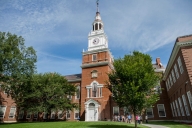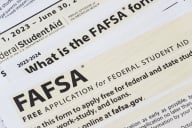You have /5 articles left.
Sign up for a free account or log in.
As Congress debates when and how the executive branch should be allowed to use drones for targeted killing in war zones, more universities here are seeking permission to use unmanned aerial vehicles.
UAVs and drones are essentially one and the same: they are radio-controlled aircraft that can be piloted from the ground. But academics don’t like the term drone because the public associates those machines with cruise missiles and privacy violations. While that’s a far cry from what these researchers use drones for, concerns about their presence in higher education remain.
It’s not entirely without basis. In 2009, the Georgia Institute of Technology’s police department applied for federal permission to use drones for surveillance at football games, freshman move-in days and other high-traffic campus events. The Federal Aviation Administration turned the department down, but the request raised red flags with civil liberties advocates when the application surfaced last month thanks to a Freedom of Information Act request. Georgia Tech police haven't pursued the plan since.
The university's academics, however, continue to use the UAVs. Their research is advancing the algorithms and methods that would allow different technologies to work together -- an unmanned helicopter and an unmanned ground vehicle coordinating to assist first responders in a shooting scenario, for instance.
" 'Drones’ is in the lexicon of the media, but it’s not really an appropriate term for what we’re doing,” said Ben Trapnell, the associate professor of aeronautics who started the University of North Dakota’s undergraduate program in UAVs four years ago.
Some universities have been using UAVs for years -- even decades – but they gained renewed attention for it this month, when the FAA released a list of all the organizations that had applied for authorized drone use. (Legally, only government-related organizations may be licensed to use specific drones in specific places, and a new license is required for each new drone or flight area.)
A full third of the applicants on the list – released after the Electronic Frontier Foundation filed a FOIA request – are colleges and universities.
“The research has been going on for a long time,” said Lora Weiss, technical director for autonomous systems for the Georgia Tech Research Institute. (She herself has been doing it for 20 years.) “What has started taking off is the realization that these UAVs are small and cheap.”
Universities That Have Applied for Drone Use Authorization
-California State University at Fresno
-Cornell University
-Eastern Gateway Community College
-Georgia Institute of Technology
-Indiana State University
-Kansas State University
-Lorain County Community College
-Middle Georgia College
-Middle Tennessee State University
-Mississippi State University
-New Mexico Institute of Mining and Technology
-New Mexico State University
-Nicholls State University
-Northwestern Michigan College
-Ohio University
-Oregon State University
-Pennsylvania State University
-Sinclair Community College
-Texas A&M University at Corpus Christi
-Texas A&M University, Texas Engineering Experiment Station
-Texas State University
-University of Alaska at Fairbanks
-University of Arizona
-University of California at Davis
-University of California at Merced
-University of Colorado at Boulder
-University of Connecticut
-University of Florida
-University of Michigan
-University of North Dakota
-University of Oklahoma
-University of Wisconsin
-Utah State University
-Virginia Commonwealth University
-Virginia Tech
--West Virginia University
And commercial enterprises are noticing their potential (though the FAA does not currently allow drone use for commercial purpose, which is why the Tacocopter may -- sadly or fortunately, depending on one’s cynicism about American culture -- never come to pass). A commonly cited example is agriculture: If UAVs could be flown over crops to survey for poor health, insect infestation and the like, pesticide use and watering could be targeted for the areas where they're actually needed, as opposed to being needlessly sprayed over the entire crop. This would save money, resources, and environmental stress.
President Obama and his nominee to head the Central Intelligence Agency, John Brennan, have been getting grilled by journalists and politicians over the secrecy surrounding the federal government’s drone strikes, particularly its justification of killing American citizens with ties to al-Qaida with no due process. Obama said last week he would work with Congress to help the public understand drone policy.
At the same time, the FAA is trying to figure out how to expand drone use to meet demand from the Department of Defense, academic institutions, the National Aeronautics and Space Administration, local law enforcement agencies and potentially commercial purposes, while still addressing safety and privacy concerns.
The safety issue is part of what some researchers are working on. If a pilot loses sight of a UAV, could it fly home? Pick back up on the transmission link? Land automatically? What happens when two UAVs collide?
That’s the sort of work done by Michael Braasch, an electrical engineering and principal investigator with Ohio University’s Avionics Engineering Center. On manned aircraft, pilots can see other planes and avoid them. That’s not always the case with unmanned vehicles. So Braasch is using small, radio-controlled aircraft to research “sense and avoid” technologies, to make sure UAVs aren’t up in the sky crashing into one another.
“There’s an attractiveness to these small aircrafts, because it doesn’t require the same kind of investment that is required for a manned aircraft,” Braasch said. “And with electronic sensor packages being pretty small, you can do a lot of interesting research, even on a small aircraft.”
The University of Florida uses the aircraft to survey the wildlife researchers are studying. The University of Colorado at Boulder is flying UAVs into huge thunderstorms to track their development into tornadoes. NASA uses them to monitor wildfires. Their potential for disaster relief and emergency response – perhaps responding to a school shooting – is huge, Georgia Tech's Weiss said.
“Unmanned aircraft systems are poised to absolutely explode – and I hate to use the term explode – in terms of their capabilities and the uses that people have,” Trapnell said. “The unmanned aircraft is a tool to do the dull, dirty and dangerous – it is not there per se to be Big Brother.”
Jack Langelaan, an associate professor of aerospace engineering at Pennsylvania State University, wants to use them to replicate albatross flights. Albatrosses, with their 10-foot wingspan, enjoy “dynamic soaring,” where they harness the change in wind speed above the ocean (it shifts from nearly 0 miles per hour at the surface to 30 mph 30 feet up) to soar for six kilometers without a single flap of the wings. By using a same-size plane to mimic those flights, scientists can learn more about albatross behavior.
The FAA denied Langelaan’s permit request because Penn State is not a state institution (in a technical sense), but he’s working around that by teaming up with colleagues at Virginia Tech.
Up until now, Langelaan’s been using simulation to mimic albatross flights. But the results aren’t as pure because some real-life factors can’t be modeled through simulation – either because it’s too difficult or because they are simply unknown. For instance, you can simulate turbulence, but how do you know how strong it should be?
“The purpose of doing the hardware testing is that you are really doing something for real,” Langelaan said. “You always learn something from those real tests.”
Matt Waite at the University of Nebraska at Lincoln is using the aircraft for a considerably different purpose than most: journalism.
Waite’s work through his Drone Journalism Lab aims to gauge unmanned vehicles as a potential tool for media. Right now, that’s illegal, because of the no-commercial-use rule. (The now-defunct The Daily used UAVs to take video in Alabama a couple years ago after tornadoes ravaged the area and the FAA shut them down.)
But as the policy discussions play out in government – and ultimately, Waite expects, the courts – he’s testing drones as a tool for aerial photography, for example; how high they can go, how much they can lift. He and his graduate assistants are also mulling over the ethical implications of drone use among the media.
While Waite appreciates the civil liberty concerns, he cautions against worrying about something that’s already illegal (say, peeping through someone’s window).
Much of the concern over drones stems from people’s uneasiness with the technology, not with what it’s doing. For instance, some states are considering banning drone use for aerial photography – despite the fact that manned aircraft do that all the time.
“Is this a new ethical problem, or is this an old ethical problem with new technology?” Waite said. “When people start realizing the kinds of benefits of them, they'll start to relax a little bit. I understand why people are concerned about privacy, and they should be concerned…. But I would also remind people that they should be concerned about using their phones and posting on Facebook, because those things are a far, far greater risk to your privacy than a UAV is.”








